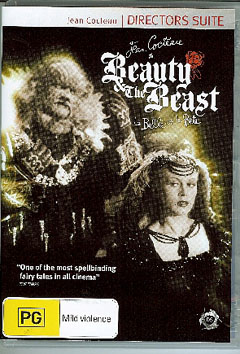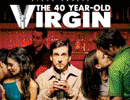Beauty and the Beast (Belle et la Bête, La) (Directors Suite) (1946) |
|
Beauty and the Beast (Belle et la Bête, La) (Directors Suite) (1946) |
|


|
| BUY IT |
| General | Extras | ||
| Category | Fantasy | Collector Card-Specially Designed Art Cards | |
| Rating |

|
||
| Year Of Production | 1946 | ||
| Running Time | 93:34 (Case: 118) | ||
| RSDL / Flipper | Dual Layered | Cast & Crew | |
| Start Up | Menu | ||
| Region Coding | 4 | Directed By |
Jean Cocteau René Clément |
|
Studio
Distributor |
 Madman Entertainment |
Starring |
Jean Marais Josette Day Mila Parély Nane Germon Michel Auclair Raoul Marco Marcel André |
| Case | Amaray-Transparent | ||
| RPI | $34.95 | Music | Georges Auric |
| Video | Audio | ||
| Pan & Scan/Full Frame | None | French Dolby Digital 2.0 (224Kb/s) | |
| Widescreen Aspect Ratio | None | ||
| 16x9 Enhancement | No | ||
| Video Format | 576i (PAL) | ||
| Original Aspect Ratio | 1.33:1 | Miscellaneous | |
| Jacket Pictures | No | ||
| Subtitles | English | Smoking | No |
| Annoying Product Placement | No | ||
| Action In or After Credits | No | ||
The multi-talented artist, in the classical sense of the word, probably doesn't exist anymore. Not since Andy Warhol in the 1960's has a visual artist come to be seen as influential in a variety of media.
Frenchman Jean Cocteau (1889 - 1963) was first and foremost a poet. He published his first volume of poetry at the age of 19 and this poetic sensibility came to inform all his other works across various media.
In 1917, at the request of Russian ballet master Sergei Diaghilev, he wrote the ballet Parade which, though hated at the time, is one of those works that changes the way people think about art forever. Parade was designed by Pablo Picasso and featured the music of French composer Erik Satie. Cocteau merely emerged from the production bearing the label of "cultural anarchist", Satie spent 8 days in prison for his involvement in this surrealistic masterpiece.
Cocteau became involved in cinema as a sideline to his poetry and his output contains only two recognised classics, this film and Orphee (Orpheus).. His first work, Le sang d'un poete (The Blood of the Poet) in 1930 is a short, almost incomprehensible piece featuring actors striking strange classical tableau.
La belle et la bete (Beauty and the Beast) came some 16 years later. It was adapted from the original fairy story by Jeanne-Marie Leprince De Beaumont. The film is a fantasy for adults, although most people familiar with the story would be better acquainted with the Disney animated version featuring singing kettles and the like.
The plot of Beauty and The Beast is fairly well known. Belle is the downtrodden youngest of three daughters of a failed merchant. The sisters are cruel and dismissive of her and her brother, though loving, is an incorrigible wastrel who puts his own interests above everyone else. The father is on the verge of bankruptcy when he receives good news. A ship has come into the harbour bearing his goods (others having sunk) and he will now be able to pay off his creditors and set his family up for life.
Upon arriving at the harbour he learns that the goods have all been taken by his creditors and there is nothing left for him to sell. In the meantime, his son has borrowed money to pay off his own debts, unaware of his father's current predicament.
As the father returns from the harbour through a forest, he comes upon a strange castle. He takes refuge in the castle during the dark and stormy night. The castle is like no other. Hands holding candelabra emerge from the walls and the faces on the statues all move! Eventually he falls asleep but is awoken in the morning by distant howling.
As he leaves the castle he remembers the gifts that his daughters had requested that he bring back from port. The elder sisters had requested fabulous gifts which he cannot provide. Belle, however, made only one request. A single rose.
Seeing roses all along the fence outside the castle the father plucks one only to be confronted by the fearsome beast. For reasons best known to fairytales, the Beast states that he has only one prized possession which is his rose bushes and the penalty for stealing a rose is death. He will only escape this fate if he sends back one of his daughters to a take his place. Upon hearing the story Belle is so struck by guilt that she returns willingly to the Beast's castle. There the Beast cares for her and treats her kindly and she ever so gently comes to love the beast in spite of his frightening appearance.
The influences of poetry upon Cocteau can be seen throughout the film. He is not a particularly good actors' director and the group scenes in particular are a little hammy. Where he excels is in the creation of mood. In this he is aided by the wonderful black and white cinematography of Henri Alekan and the moving score by George Auric.
There is a luminous quality to the whole film which works best when Beauty and the Beast are together. The costuming is superb and the gowns are delicately embroidered to give off a shower of sparkles under the lights.
The French actor, Jean Marais, plays three roles including the Beast. To play the role he endured a 5 hour makeup ritual each day. However, this was one of the most trifling problems experienced by Cocteau in making the movie. The Criterion Collection essay relates the enormous problems that Cocteau faced when trying to make the film in post war France where he was surviving on American food packages. The film stock was gathered from all sources which is noticeable in the finished product.
Cocteau, however, said that this enhanced the film rather than hampering his vision. It is a testament to the acting of Jean Marais that underneath the beast make up he is able to convey such sadness and love. His soft voice is a contrast to the hideousness of the Beast. Yet when he changes to the dandy prince the sense of disappointment in Belle is palpable.
To say that Beauty and The Beast is amongst the finest fantasies ever made is probably damning it with faint praise given the limited number of fantasies that actually make it to the big screen. It is enjoyable from beginning to end and is genuinely moving. Being the complete artist that he was, Cocteau even manages to sneak himself into the opening credits which are written on the blackboard and then erased.
Any fan of Cocteau or 1940's French cinema will find a good deal of merit in this film.
Beauty and The Beast is presented on DVD in a 1.33:1 aspect ratio, almost identical to its cinematic 1.37:1 aspect.
The case for the DVD mentions nothing about the origin of the print. However, the film features a title screen pointing out that the print has been restored. Specifically, it is not clear whether the restoration dates back to the pre-digital era. Whatever the origin, I can report that the transfer looks remarkably good. There are minimal artefacts and an absence of damage to the print. The frame occasionally jumps a bit but this is not too distracting.
The picture is intentionally soft and overlit on the faces.
The grain is noticeable but not distracting. The only flaw I can mention without being too picky is the slight flickering throughout which is not helped by the difference in the various film stocks.
The subtitles are clear and easy to read although the opening subtitles during the credit sequence are yellow in colour and the film features white subtitles.
Given the history of the film it is a minor miracle that it still exists let alone that it looks this good.
| Sharpness | |
| Shadow Detail | |
| Colour | |
| Grain/Pixelization | |
| Film-To-Video Artefacts | |
| Film Artefacts | |
| Overall |
The sound for Beauty and The Beast is French Dolby Digital Mono 2.0 running at 224 Kb/s.
This is perfectly adequate for the dialogue and even conveys the music of George Auric in some style.
The audio sync appears to be fine.
There is no damage to the sound and hiss is kept to a minimum.
All in all a quite acceptable sound transfer.
| Dialogue | |
| Audio Sync | |
| Clicks/Pops/Dropouts | |
| Surround Channel Use | |
| Subwoofer | |
| Overall |
The extras are practically non-existent. The DVD includes a series of art-cards which are nice to look at but it really cries out for a commentary or some documentary about Cocteau.
NOTE: To view non-R4 releases, your equipment needs to be multi-zone compatible and usually also NTSC compatible.
Beauty and The Beast has been released in Region 2 and in Region 1 through the Criterion collection. Sad to say that both versions are more fully featured than the Region 4 version.
The Region 2 United Kingdom version has an audio commentary by writer and cultural historian, Professor Sir Christopher Frayling, and contains a documentary of approximately 27 minutes length called "Screening at The Majestic" from 1995. It also contains some stills, film posters and engravings.
As might be expected, the Criterion Collection is exhaustingly featured. As well as the Frayling commentary, there is a critic commentary by Arthur Knight. In the 90's Phillip Glass, the noted minimalist composer wrote an opera which can be played as an alternate sound track to the film. This has been included on this set. There is also the Majestic documentary and an interview with cinematographer Alekan of approximately 10 minutes length. There is an excerpt from a French TV show featuring the makeup artist who worked on the Beast's makeup, the original 1945 theatrical trailer and some other materials relating to the restoration. Finally, there is a 32 page booklet included.
Beauty and The Beast won't appeal to everyone but it is a supremely beautiful film with a poetic sensibility rarely found in "mainstream " cinema.
The sound and picture quality is exceptional given the age and desperate circumstances in which the film was made.
The extras are sadly non-existent.
| Video | |
| Audio | |
| Extras | |
| Plot | |
| Overall |
| Review Equipment | |
| DVD | Pioneer BDP-LX70 Blu-ray Player, using HDMI output |
| Display | Pioneer PDP-5000EX. This display device has not been calibrated. This display device is 16x9 capable. This display device has a maximum native resolution of 1080p. |
| Audio Decoder | Built in to amplifier/receiver. Calibrated with Ultimate DVD Platinum. |
| Amplification | Onkyo TX-SR605 |
| Speakers | JBL 5.1 Surround and Subwoofer |